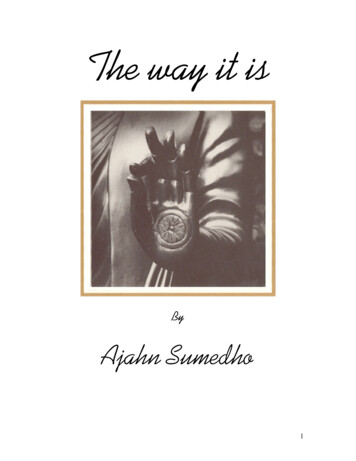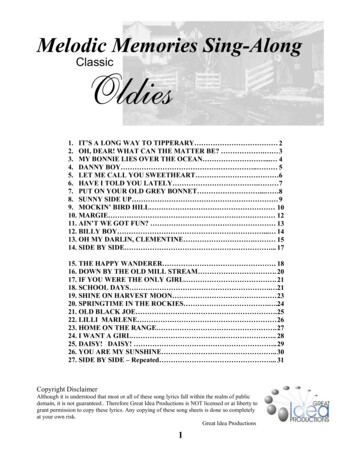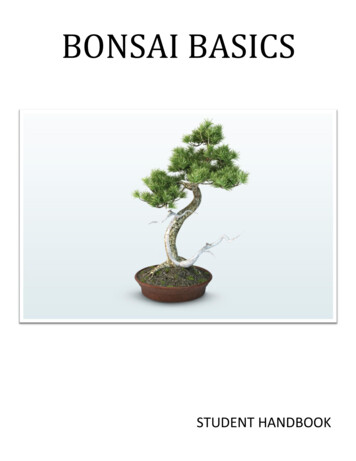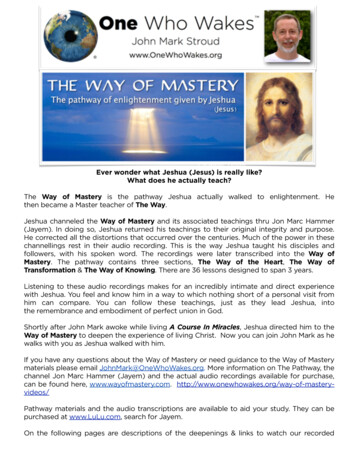
Transcription
The way it isByAjahn Sumedho1
Ajahn Sumedho2
Venerable Ajahn Sumedho is a bhikkhu of the Theravada school of Buddhism, a traditionthat prevails in Sri Lanka and S.E. Asia. In this last century, its clear and practicalteachings have been well received in the West as a source of understanding and peacethat stands up to the rigorous test of our current age.Ajahn Sumedho is himself a Westerner having been born in Seattle, Washington, USA in1934. He left the States in 1964 and took bhikkhu ordination in Nong Khai, N.E.Thailand in 1967. Soon after this he went to stay with Venerable Ajahn Chah, a Thaimeditation master who lived in a forest monastery known as Wat Nong Pah Pong inUbon Province. Ajahn Chah’s monasteries were renowned for their austerity andemphasis on a simple direct approach to Dhamma practice, and Ajahn Sumedhoeventually stayed for ten years in this environment before being invited to take upresidence in London by the English Sangha Trust with three other of Ajahn Chah’sWestern disciples.The aim of the English Sangha Trust was to establish the proper conditions for thetraining of bhikkhus in the West. Their London base, the Hampstead Buddhist Vihara,provided a reasonable starting point but the advantages of a more gentle ruralenvironment inclined the Sangha to establishing a forest monastery in Britain. This aimwas achieved in 1979, with the acquisition of a ruined house in West Sussexsubsequently known as Chithurst Buddhist Monastery or Cittaviveka.With the foundation of a proper monastery, the Sangha began to grow in numbers quitesteadily and also took on a training for women as Buddhist nuns (siladhara). The increasein the numbers of people wishing to live the monastic life, or to help support it, made itpossible to set up branch monasteries in Britain and also overseas; it also helped to bringabout the establishment of a large-scale teaching center, Amaravati Buddhist Monastery,in 1984. This is where Ajahn Sumedho customarily resides and many of the talksincluded in this book were given there.Amaravati Buddhist Monastery is just outside the village of Great Gaddesden near HemelHempstead in Hertfordshire. It is both a monastery and a retreat center and welcomesthose who are interested in the teachings of the Buddha. Visitors may stay as guests ofthe monastery if they are interested in living in a community and training in terms ofmorality, awareness and service. This publication is part of the service that Amaravatiundertakes and has been made available through voluntary efforts and donations.Amaravati has produced several other books of teachings by Ajahn Sumedho, and alsodistributes books by Ajahn Chah and other Buddhist masters. For a current list, pleasesend a SAE to Amaravati Publications, Great Gaddesden, Hemel Hempstead, Herts, HPI3BZ, England.3
DEDICATIONIn memory ofPraya and Khunying Chavakij Banharn4
Free distribution pagePublication from Amaravati.This work may be copied or reprinted,without permission from the copyright holder,for free distribution only. Otherwise, all rights reserved.This publication as with most publications is made possibleThrough offerings from individuals and/or groups, givenSpecifically for the publication of Buddhist teachings.Further information is available from the address below.Sabbadanam dhammadanam jinatiThe gift of Dhamma surpasses all other giftsCopyright Amaravati Publications 1991Amaravati PublicationsAmaravati Buddhist MonasteryGreat GaddesdenHemmel HempsteadHertfordshire HPI 3BZEnglandISBN 1 870205 11 15
CONTENTSINTRODUCTION .7‘ . . . Happiness forever’ .11INVESTIGATING THE MIND .14EVERYTHING THAT ARISES PASSES AWAY .21THE FIVE KHANDHAS .28‘ . . . All the time in the world’ .38PRECEPTS .39‘THE WAY IT IS’ .46THE RAFT .49PATIENCE .56REFLECTIONS ON FOOD .60ACCEPTING THE WAY THINGS ARE .61CONSCIOUSNESS AND SENSITIVITY .65THE SOUND OF SILENCE .72ONLY ONE BREATH .74STILLNESS AND RESPONSE .81TURNING TOWARDS EMPTINESS .89BEYOND BELIEF .96BEING NOBODY .102NON-DUALISM .110DEPENDENT ORIGINATION .113IGNORANCE IS THE SELF-VIEW .115MOMENTARY ARISING .122THE FORMATIONS OF SELF .127FEELING CONDITIONS DESIRE .134LETTING GO OF DESIRE .142THE SHINING-THROUGH OF THE DIVINE .151A TIME OF LOVE .162REFLECTIONS ON BENEVOLENCE .1706
INTRODUCTIONThis book contains a collection of teachings of Ajahn Sumedho given topeople who are familiar with the conventions of Theravada Buddhism andhave some experience of meditation. Most of the chapters are edited fromtalks either given during retreats for lay people or for Ajahn Sumedho’smonastic (ordained) disciples, so they require some careful attention and arebest read in sequence.In the two – month monastic retreats Ajahn Sumedho develops a theme fromthe Buddha’s teaching, linking it to other aspects of the Dhamma,embellishing it with accounts of his personal experiences, demonstrating itsrelevance to the society in general, or using it as an exhortation to theSangha to live up to their aspiration of enlightenment. Although it is notpossible to render the tonal depth and variety of these talks in a printedwork, the mixture of short exhortations and pointers, and longercontemplative reflections mingled with the chants that the monks and nunshave been reciting daily for years may suggest the atmosphere and scopewithin which the teachings are offered.In many of these talks Ajahn Sumedho expounds on the uniquely Buddhistexpression of ‘not-self’ (anatta). He maintains this to be the Buddha’s wayof pointing to the experience of Ultimate Reality that is the goal of manyreligions. During the monastic retreats, Ajahn Sumedho frequently teachesDependent Origination (paticcasamuppada) based on the approach of anatta.The Dependent Origination traces the process whereby suffering (dukkha) iscompounded out of ignorance (avijja) and, conversely, suffering iseliminated (or rather not created) with the cessation of ignorance. Just asanatta, not-self, is the expression of Ultimate Truth, Ajahn Sumedhosuggests that the root of ignorance is the illusion of ‘Self’. He is trying not toannihilate or reject personal qualities but rather to point out how suffering(dukkha) arises through attempting to sustain an identity denoted by bodyand mind.This mistaken identity is what the average person calls ‘myself’. It can bedetected in a latent state as self-consciousness, as a habitual mood of the7
mind such as conceit or self-criticism, or it can manifest as selfish bodily orverbal activity. The profundity of Dependent Origination is that it describeshow, even at its most passive, such wrong view creates habitual drives(kamma) and attitudes through which even a silent and well-intentionedmeditator experiences suffering. Kamma ranges from the ‘internal’,psychological plane to the ‘outer’ realm of action. This habitual process thenmanifests in terms of body, speech or mind; all such manifestations beingtermed sankhara. Even moral action based on ‘self-view’ can lead toanxiety, doubt, ‘sorrow, grief, pain, lamentation and despair’. Such is themeaning of the first ‘link’ of Dependent Origination ‘avijja paccayasankhara’ or ‘dependent on ignorance are kammic formations’.In its most complete formulation, Dependent Origination is expressed as:‘avijjapaccaya sankhara; sankharapaccaya vinnanam; vinnanapaccayanamarupam; namarupapaccaya salayatanam; salayantanapaccaya phasso;phassapaccaya vedana; vedanapaccaya tanha; tanhapaccaya upadanam;upadanapaccaya bhavo; bhavapaccaya jati; jatipaccaya jaramaranamsoka-parideve-dukkha-domanassupayasa sambhavanti, evametassakevalassa dukkhakhandassa samudayo hoti.’This deals with arising of dukkha.The cessation of dukkha is then mapped out:‘avijjayatveva asesaviraga-nirodha sankharanirodho; sankharanirodhavinnananirodho; vinnananirodha namarupanirodho; namarupanirodhasalayatananirodho; salayatananirodha phassanirodho; phassanirodhavedananirodho; vedananirodha tanhanirodho; tanhanirodhaupadananirodho; upadananirodha bhavanirodho; bhavanirodhajatinirodho; jatinirodha jaramaranam-soka-parideva-dukkhadomanassupayasa nirujjhanti; evametassa kevalassa dukkhakhandhassanirodho hoti’.In English this can be translated as:Dependent on ignorance are habitual formations; dependent on habitual(kamma) formations is consciousness; dependent on consciousness arename-and-form (mentality-corporeality); dependent on name-and-form arethe six sense-bases; dependent on the six sense bases is contact; dependenton contact is feeling; dependent on feeling is desire; dependent on desire is8
grasping is becoming; dependent on becoming is birth; dependent on birth isold age, sickness and death, sorrow, grief, lamentation, pain and despair.Through the entire ceasing of this ignorance, habitual formations cease;through the ceasing of habitual formations, consciousness ceases; throughthe ceasing of consciousness, name-and-form cease; through the ceasing ofname-and-form, the six sense-bases cease; through the ceasing of the sixsense bases, contact ceases; through the ceasing of contact, feeling ceases;through the ceasing of feeling, desire ceases; through the ceasing of desire,grasping ceases; through the ceasing of grasping, becoming ceases; throughthe ceasing of becoming, birth ceases; through the ceasing of birth, old age,sickness and death, sorrow, lamentation, pain, grief and despair come tocease. Thus is the ceasing of this whole mass of suffering.There are many forms of dependence that are concerned in this analysis. It ishelpful to remember that paccaya ‘dependent on’ or ‘conditions’ does notnecessarily mean ‘creates’. For example, one could say ‘walking isdependent on legs’, or ‘ice is dependent on water’, or ‘catching the train isdependent on getting to the station at the right time’, or even ‘the view isdependent on the non-appearance of intervening objects’. Understandingthis, the contemplative begins to realize that just as ‘arising dependence’,need not mean ‘creation’, the ‘cessation’, so valued by the Buddha need notmean ‘annihilation’. In this lifetime, where Nibbana is to be realized,mentality-corporeality can ‘cease’ – i.e. the identification with physical andmental kamma-formations can cease so that life is no longer lived from thepleasure/pain principle dictated by the senses. (nama-rupa-salayatanaphassa-vedana-tanha). In this spirit, one could interpret the sequence in amore fluid way, for example:To the extent which (paccaya) the mind has not comprehended (avijja)Truth, habitual drives (sankhara) manifest and condition (paccaya)awareness into a discriminative mode (vinnana) that operates in terms of(paccaya) subject and object (nama-rupa) held (paccaya) to exist on eitherside of the six sense-doors (salayatana).These sense-doors open dependent (paccaya) on contact (passa) that canarouse (paccaya) varying degrees of feeling (vedana). Feeling stimulates(paccaya) desire (tanha) and, according to (paccaya) the power of desire,attention lingers (upadana) and so personal aims and obsessions develop(bhava) to give (paccaya) the cycle of maturing and passing away (jara9
maranam) with the resultant sense of sadness (soka) varying from sorrow(parideva) depression (dukkha) and emotional breakdown (upayasa).When the mind looks into the sense of loss and comprehends Truth (avijjanirodha), habitual drives cease (sankhara-nirodha) and the awareness is nolonger bound by their discrimination (vinnana-nirodha); so that theseparation of the subject and object is no longer held (nama-rupa nirodha).The sense-doors open for refection, rather than being dependent on contact(phassa-nirodha) and impingement does not impress itself into the mind(vedana-nirodha). So there is freedom from desire (tanha-nirodha) andattention does not get stuck (upadana-nirodha) and grow into selfishmotivations (bhava-nirodha). When no personal image is created, it cannever bloat up, nor can it be destroyed (jara-maranam-nirodha). So there isnothing to lose, a sense of gladness, uplift, joy and serenity h the cessation of such a death-bound frame of reference there is theliving of the True life, the Holy life, of which Ajahn Sumedho soevocatively speaksAlthough many of these talks were delivered to monastics, the beauty of theDhamma is that it is available to those who wish to9 listen. It is with this inmind that this book is freely offered.May all beings realise Truth,Ven. Sucitto BhikkhuAmaravati 199010
‘ . . . Happiness forever’. . . We have been meditating, watching our breath, contemplating theinhalation and the exhalation. We’re using bare attention, mindfulness of thebody while walking, standing, sitting and lying down. Rather than becomingfascinated, we’re opening the mind to conditions as they are at the presenttime.Notice how even in a beautiful place like this we can really make ourselvesmiserable. When we are here, we might want to be somewhere else; whenwe are walking, we might want to be sitting; when we are sitting, we mightwant to be walking. When we are meditation, we are thinking what we’ll doafter the retreat. Then after the retreat, we wish we were back here . . .hopeless, isn’t it?Before you came to this retreat, you were having problems at home and youwere thinking, ‘I can hardly wait for the retreat to end.’ Maybe you get verytranquil sitting there thinking, ‘I want to be like this all the time,’ or you tryto get that blissful state you had yesterday but instead get more and moreupset.When you get this nice blissful states you grasp them; but then you have toget something to eat or eat or do something. So you feel bad at losing theblissful state. Or maybe you haven’t been getting any blissful states at all:just a lot of miserable memories and anger and frustrations arise. Everyoneelse is blissful; so then you feel upset because everybody else seems to begetting something from this retreat except you . . .This is how we begin to observe that everything changes. Then we have thepossibility to observe how we create problems or attach to the good or createall kinds of complexities around the conditions of the moment; wantingsomething we don’t have, wanting to keep something we have, wanting toget rid of something we have. This is the human problem of desire, isn’t it?We’re always looking for something else.I remember as a child wanting a certain toy. I told my mother that if she gotthat toy, I’d never want anything ever again. It would completely satisfy me.And I believed it – I wasn’t telling her a lie; the only thing that was stopping11
me from being really happy then was that I didn’t have the toy that I wanted.So my mother bought the toy and gave it to me. I managed to get somehappiness out of it for maybe five minutes . . . and then I had to start wantingsomething else. So in getting what I wanted, I felt some gratification andhappiness and then desire for something else arose. I remember this sovividly because at that young age, I really believed that if I got that toy that Iwanted, I would be happy forever . . . only to realize that ‘happiness forever’was an impossibility . . .12
Bhikkhu meditating outside his kutiPhoto by John Johns13
INVESTIGATINGTHE MINDThe root of suffering is what we call avijja – not knowing, or ignorance ofthe way things really are. This basic ignorance is one of not understandingour true nature. We suffer because of views and opinions, and because ofhabits and conditions which we do not understand. We live our lives in astate of ignorance, not understanding the way thins are.If you listen to yourself very much, you can sometimes hear such statementsas, ‘I should do this but I shouldn’t do that, I should be this way, I shouldn’tbe that way,’ or that the world would be other than it is; our parents shouldbe this way or that way and shouldn’t be the way they are. So we have thisparticular verb tense ringing through our minds because we have an idea ofwhat shouldn’t be or should be. In meditation, listen to hat opinion withinyourself of what should be and what shouldn’t be - just listen to it.Our tendency is to try to become something; so we set a goal, create an idealof what we would like to become. Maybe we think society should be otherthan it is. People should be kind, generous, unselfish, understanding andloving; there should be brotherhood; the government should have wiseleaders and the world should be at peace. But the world is as it is at thismoment in time and things are struggling. So listen inwardly to yourselves,to the constant crying. ‘I am this way, I am not this way,’ and penetrate this‘I am, I am not’ with awareness.We tend to just react and take it for granted that all the ‘I am’ and ‘I am not’is the truth. We create ourselves as a personality and attach to our memories.We remember the things we’ve learned and what we’ve done – generally themore extreme things; we tend to forget more ordinary things. So if we dounkind, cruel, foolish things then we have unpleasant memories in our lives;we feel ashamed or guilty. If we do good or charitable things, then we havegood memories in our lives. When we start reflecting on this, then we aregoing to be more careful about what we do and say; if we have lived lifefoolishly, acting on impulse out of desire for immediate gratification or outof an intention to hurt, cause disharmony or exploit others, our minds will befilled with very unpleasant memories. People who have led very selfish lives14
have to drink a lot or take drugs to keep themselves constantly occupied sothat they don’t have to look at the memories that come up in the mind.In the awakening process of meditation, we are bringing awareness to theconditions of the mind here and now just by being aware of this sense of ‘Iam, I am not’. Contemplate the feelings of pain or pleasure – and anymemories, thoughts and opinions – as impermanent, annica. Thecharacteristic of transience is common to all conditions. How many of youspent the day really investigating this in every possible way while sitting,standing or lying down? Investigate what you see with your eye, hear withyour ear, taste with our tongue, smell with your nose, feel and experiencewith your body and think with your mind.The thought ‘I am’ is an impermanent condition. The thought ‘I am not’ isan impermanent condition. Thoughts, memories, consciousness of thinking,the body itself, our emotions – all conditions change. In the practice ofmeditation, we have to be quite serious, brave and courageous, to reallyinvestigate, to dare to look at even the most unpleasant conditions in life,rather than to seek escape in tranquility or forget about everything. InVipassana, the practice is one of looking into suffering; it’s a confrontationwith ourselves, with what we think of ourselves, with our memories and ouremotions, pleasant, unpleasant or indifferent. In other words, when thesethings arise and we are aware of suffering, rather than rejecting, repressingor ignoring it, we take the opportunity to examine it.So suffering is our teacher. We have to learn the lesson by studyingsuffering itself. It always amazes me how some people think they neversuffer. They think, ‘I don’t suffer. I don’t know why Buddhists talk aboutsuffering all the time. I feel wonderful, full of beauty and joy. I’m so happyall the time. I find life one fantastic experience, interesting, fascinating and anever-ending delight.’ These people just tend to accept that side of life andreject the other because inevitably what delights us disappears and then weare sorry.Our desire to be in a constant state of delight leads us into all kinds ofproblems, difficulties and situations. Suffering is not just because of massivethings like having terminal cancer, or losing someone you love; sufferingcan occur around what is very ordinary, like the four postures of sitting,standing, walking, lying down. There’s nothing extreme in that.15
We contemplate the normal breath, and the ordinary consciousness. In orderto understand existence, we contemplate ordinary feelings, memories andthoughts rather than grasp hold of fantastic ideas and thoughts to understandthe extremes of existence. So we’re not getting involved with speculationabout the ultimate purpose of life, God, the devil, heaven and hell, whathappens when we die or reincarnation. In Buddhist meditation you justobserve the here and now. The birth and death that’s going on here and nowis the beginning and ending of the most ordinary things.Contemplate beginning. When you think of birth you think of ‘I was born’,but that is the great birth of the body, which we can’t remember. Theordinary birth of ‘me’ which we experience, in daily life is ‘I want, I don’twant, I like, I don’t like.’ That’s a birth, or seeking to be happy. Wecontemplate the ordinary hell of our own anger, the anger that arises, theheat of the body, the aversion, the hatred we feel in the mind. Wecontemplate the ordinary heaven we experience, the happy states, the bliss,the lightness, the beauty in the here and now. Or just the dull state of mind,the kind of limbo, neither happy nor unhappy, but dull, bored andindifferent. In Buddhist meditation we watch this within ourselves.We contemplate our own desire for power and control, to be in control ofsomeone lese, to become famous, or to become someone who is on top. Howmany of you, when you find out someone is more gifted than you are, wantto put them down? This is jealousy. What we have to do in our meditationpractice is see the ordinary jealousies, or the hatred we might feel forsomeone who might take advantage of us, or annoys us; the greed or lust wemight feel for someone who attracts us. Our own mind is like a mirror whichreflects the universe and you watch the reflection. Before, we would takethese reflections for reality so that we became entranced, repelled orindifferent to them. But in Vipassana we just observe that all thesereflections are changing conditions. We begin to see them as objects ratherthan as a self, where as when we’re ignorant we tend to seek identity withthem.So in practice we are looking at the universe as it is being reflected in ourminds. It does not matter what anyone else experiences; one meditator willsit here and experience all sorts of brilliant lights, colors, fascinating images,Buddhas, celestial beings – even smell wonderful odors, hear divine sounds– and think, ‘What a wonderful meditation? Such brilliance came, suchradiance? A divine being like an angel touched me and I felt this ecstasy.16
I’ve waited my whole life for this experience.’ Meanwhile the next one isthinking, ‘ Why doesn’t something like that ever happen to me? I sat for awhole hour in pain with an aching back, depressed, wanting to run away,wondering why on earth I’d come to this retreat anyway.’ Another personmight say, ‘I can’t stand all those people who have those silly ideas andfantasies. They disgust me; they just develop this terrible hatred andaversion in me. I hat e the Buddha image sitting in the window. I want tosmash it. I hate Buddhism and meditation?’Now which of these three people is the good meditator Compare the onewho sees devas and experiences bright lights, you start doubting your ownpractice and think, ‘Maybe I am not capable of enlightenment. Maybe I amnot meditation right.’ Doubt itself is impermanent. Whatever arises passesaway. So the good meditator is the one who sees the impermanent nature ofbliss and ecstasy or experiences dullness, anger, hatred and aversion, andreflects on the impermanent nature of those qualities when sitting, walkingor lying down.What is your tendency? Are you very positive about everything? ‘I likeeverybody here. I believe in the teachings of the Buddha, I believe in theDhamma’ – that’s a faith kind of mind. It believes, and that kind of mind cancreate and experience blissful things very quickly. You find that some of thefarmers in Thailand, people who have hardly any worldly knowledge, whocan hardly read and write, can sometimes experience blissful states, lights,devas and all that, and believe in them. When you believe in devas, you seethem. When you believe in lights and celestial realms, you’ll see them. Youbelieve that Buddha is going to save you, Buddha will come and save you.What you believe in happens to you. If you believe in ghosts, fairies andelves, you find those things manifest for you. But they are still anicca,impermanent, transient and not-self.Most people don’t believe in fairies and devas and think such things aresilly. This is the negative kind of mind, the one that’s suspicious anddoubtful and does not believe in anything. ‘I don’t believe in fairies anddevas. I don’t believe in any of that kind of thing. Ridiculous? Show me afairy.’ So the very suspicious and skeptical mind never sees such things.There is faith; there is doubt. In Buddhist practice, we examine the beliefand the doubt that we experience in our mind and we se that these two areconditions changing.17
I have contemplated doubt itself as a sign. I’d ask myself a question like,‘Who am I?’ and then I’d listen for the answer – something like, ‘SumedhoBhikkhu.’ Then I’d think, ‘That’s not the answer; who are you really? I’dsee the struggle, the habitual reaction, to find an answer to the question. ButI would not accept any conceptual answer. ‘Who is it sitting here? What isthis? What’s this here? Who is thinking anyway? What is it that thinks?When a state of uncertainty or doubt would arise, I would just look at thatuncertainty or doubt as a sign because the mind stops there and goes blank,and then emptiness arises.I found it useful to empty the mind by asking myself unanswerable questionswhich would cause doubt to arise. Doubt is an impermanent condition.Form, the known, is impermanent; not knowing is impermanent. Some daysI would go out and look at Nature and observe myself just standing here,looking at the ground. I’d ask myself, ‘Is the ground separate from myself?Who is that who sees the ground? . . . Are those leaves and the ground in mymind or outside my mind? . . . What is it that seees? Is it the eyeball? . . . If Itook my eyeball out, would it be separated from myself? . . . Would I stillsee those leaves? . . . Are they still there when I’m not looking at them? . . .Who is the one that’s conscious of this anyway?’I also did some experiments with sound because the objects of sight have acertain solidity like this room – it seems fairly permanent, you know, fortoday at least. But sound is truly anicca – try to get hold of sound.I investigated sound by asking, ‘Can my eyes hear it? If I cut off my ears andear drums, will there be any sound? Can I see and hear in exactly the samemoment?’ All sense organs and their objects are impermanent, changingconditions. Think right now, ‘Where is your mother? Where is my mother?’If I think of here in her flat in California, It’s a concept in the mind. Even if Ithink, ‘California is over there,’ that’s still the mind thinking ‘over there.’‘Mother’ is a concept, isn’t it? So where is the mother right now? She is inthe mind: when the word ‘mother’ comes up, you hear the word as a soundand it brings up a mental image or a memory or a feeling of like, dislike orindifference.All concepts in the mind which we take for reality are to be investigator:know what concepts do to the mind. Notice the pleasure you get fromthinking about certain concepts and the displeasure that others bring. Youhave prejudices and biases about race or nationality – these are all concepts18
or conceptual proliferations. Men have certain attitudes and biases aboutmen: this is just inherent in those identities.But in meditation, ‘female’ is a concept and ‘male’ is a concept, a feeling, aperception in the mind. So in this practice of Vipassana, we penetrate withinsight into the nature of all conditions. Coarse or refined. Insight breaksdown the illusions that these concepts give us, the illusions that they are real.Conditions may arise; we cant stop the things that affect us in life – such asthe weather, the economy, family problems, our background, ouropportunity or lack of opportunity But we can penetrate all these conditions– which are impermanent and not-self. This is the path of transcendence;transcending the mortal condition through awareness of the mortalcondition.The Buddha is the teacher, that within us which reminds us to observe theimpermanent nature of all conditions and not to take any of them as reality.When we do, wheat happens? We have wars, strikes, battles and endlessproblems that exist in the world because ignorant beings take theseconditions as reality. They attach to the mortal body as an identity. We getabsorbed into these various symbols and concepts, and in that absorption wehave to be born and die in those conditions. It’s like getting attached tosomething that is moving, such as greed, and being pulled along by thatmovement. So we’re born and die at that time. But when we don’t attach anymore then we’re avoiding suffering from the movement and the limitationsof changing conditions.Now talking like this, people might question: ‘How do you live in thissociety then, if it’s all unreal?’ The Buddha made a very clear distinctionbetween conventional reality and ultimate reality. On the conventional levelof existence we use conventions that bring harmony to ourselves and to thesociety we live in. What kind of conventions bring harmony? Well, thingslike being good, being mindful, not doing things that cause disharmony,such as stealing, cheating and exploiting others; having respect andcompassion for other beings, being observant, trying to help: all theseconventions bring harmony.So in the Buddhist teaching on the conventional level, we live in a way thatsupports doing good and refraining from doing evil with the body andspeech. It’s not as if we are rejecting the conventional world ‘I want nothing19
to do with it because it’s an illusion’ – that’s ano
included in this book were given there. Amaravati Buddhist Monastery is just outside the village of Great Gaddesden near Hemel Hempstead in Hertfordshire. It is both a monastery and a retr











